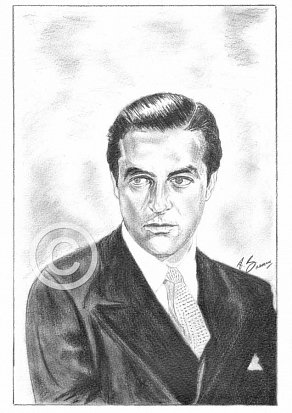Ray Milland
Pencil Portrait by Antonio Bosano.

Shopping Basket
The quality of the prints are at a much higher level compared to the image shown on the left.
Order
A3 Pencil Print-Price £20.00-Purchase
A4 Pencil Print-Price £15.00-Purchase
*Limited edition run of 250 prints only*
All Pencil Prints are printed on the finest Bockingford Somerset Velvet 255 gsm paper.
P&P is not included in the above prices.

Recommended viewing
The Lost weekend (1945)
The Thief (1952)
Sporting a major star, a sizeable budget and a fresh innovation – no dialogue throughout – this was the most highly regarded entry in the anti-Reds cannon of movies produced in the early 50’s.
Milland plays Dr Allan Fields, a scientist at the Atomic Energy Commission in Washington, who sells classified secrets to the Communists. As the movie unfolds, a phone shrills with two bursts of three rings and the man on the bed (Milland) leaves his room. Out in the night, a waiting man lights a cigarette, throws down the empty packet, and vanishes. Milland picks up the packet, reads the message in his room, resignedly gets out a micro-camera – we see a shot of an award for his services to nuclear physics – and director Russell Rouse’s movie embarks on its challenge to tell the story of a spy without dialogue. The effect is overdone a little – even the passers-by never say a word – but it’s far outweighed by Milland’s tangible sense of fear induced isolation. His motives are never explored, his contacts remain anonymous and before long, the protagonist’s caution is edging into paranoia as events turn for the worse. Rouse’s dispassionate, evenly-paced direction, abetted by Sam Leavitt’s superb noir camerawork, strands Milland in a shadowy world of fellow-humans, any one of whom might spell disaster. The moment at the end, as Milland waits despairingly for word of his escape and the focus of his attention, the alluring girl across the hall closes her door in his face, is one the French director Robert Bresson would surely have approved.
Dial M for Murder (1954)
The Safecracker (1958)
Movie review can be located on the Jeannette Sterke page.
https://www.antoniobosano.com/film/jeanette-sterke.php


Comments
Ray Milland, born Alfred Reginald Jones, was a renowned Welsh actor and director.
Born in the early twentieth century, he grew up to be a Hollywood actor who impressively personified the characters of a dipsomaniac author in ‘The Lost Weekend’ and a scheming husband who plots his wife’s murder in ‘Dial M for Murder’.
In the beginning of his career, he served in the British Household Cavalry, winning many trophies for his team. Eventually, he moved on to acting and appeared as an ‘extra’ in British films. After a brief period of unproductiveness, he featured in ‘The Flying Scotsman’ which landed him a nine-month contract with MGM. He then shifted to the United States where he appeared as a character actor. Later, he was signed by Paramount Pictures, which cast him in lesser speaking roles. In 1936, he was loaned out to Universal for a film called ‘Three Smart Girls’. The success of the film won him the lead role in ‘The Jungle Princess’, a commercial hit. His strongest performance came in 1945, in the critically acclaimed film, ‘The Lost Weekend’. He continued with Paramount Pictures for the next 20 years after which he directed films and television series. Towards the end of his career, he featured in a few television series as well.